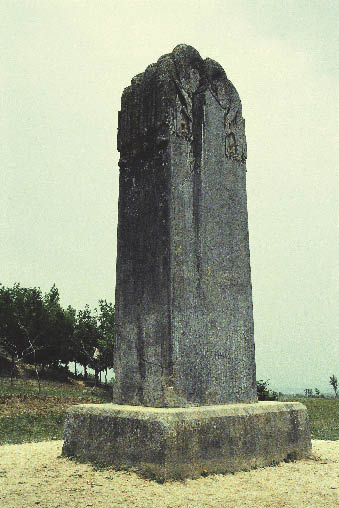|
To decorate his garden house in Beijing (where Mi served as what would now be called vice minister of transportation), Mi Wanzhong traveled the mountains around the capital and finally discovered a huge rock thrusting abruptly from a hilltop at Fangshan. He climbed the hilltop to bow to the huge stone and lavish admiration upon it. He then determined to get the rock back to his garden. He spared no money in hiring men to quarry the rock, open a mountain road and dig wells at regular intervals along the way. When winter came, he had men pour water on the road and hired dozens of horses to tow the rock on the icy path. It is said that by the time the rock got to Liangxiang, Mi had exhausted all his finances and was forced to leave the rock where it was.
But some scholars believed that it was not financial problems that forced Mi to abandon his project, for the Mi family had ample wealth. According to them, Mi's political enemy Wei Zhongxian exploited the project to frame Mi as "adding physical burdens to locals and causing financial damage." As a result, Mi was removed from his post. To avoid more problems, Mi professed financial hardship and gave up the scheme. In any case, the rock brought Mi bad luck and locals called it the "Fortune Dissipating Stone."
When Emperor Qianlong of the Qing Dynasty stopped in the area on his way to the western imperial cemetery in Hebei's Yixian County to pay homage to his ancestors, he heard about the rock and went to see it. He was also taken by its uniqueness and ordered its transportation to the Hall of Happiness and Longevity.
Mi Wanzhong's ancestral clansman Mi Fu (1051-1107) had an even greater passion for stones that won him the epithet "Stone Lunatic." He addressed stones as younger or elder brothers and would talk to them as he did people. He devoted more time and energy to his stones than to his work, and lost his official post several times due to his obsession. However, each time he was ultimately restored to his position. His invincibility was attributed not only to his outstanding artistic talent but also the cultural environment of the time –Emperor Huizong himself was a fanatical lover of art and stones.
The "Stone" Emperor
 |
| Wu Zetian's wordless stele. |
By the time Emperor Huizong was enthroned in 1101 (he ruled until 1127), the Southern Song Dynasty was in decline. Nevertheless, the new emperor cared little about the national interest and used his power to pursue his personal hobbies. An outstanding example was his use of resources for the construction of the imperial Genyue Garden in the capital of Bianliang (present-day Kaifeng in Henan).
| 